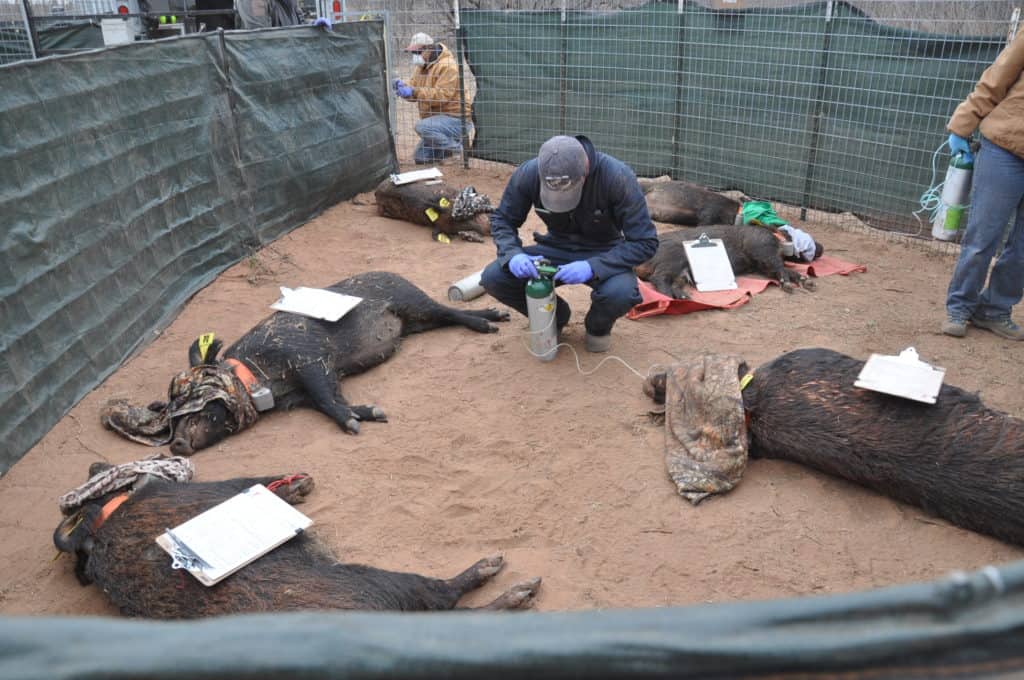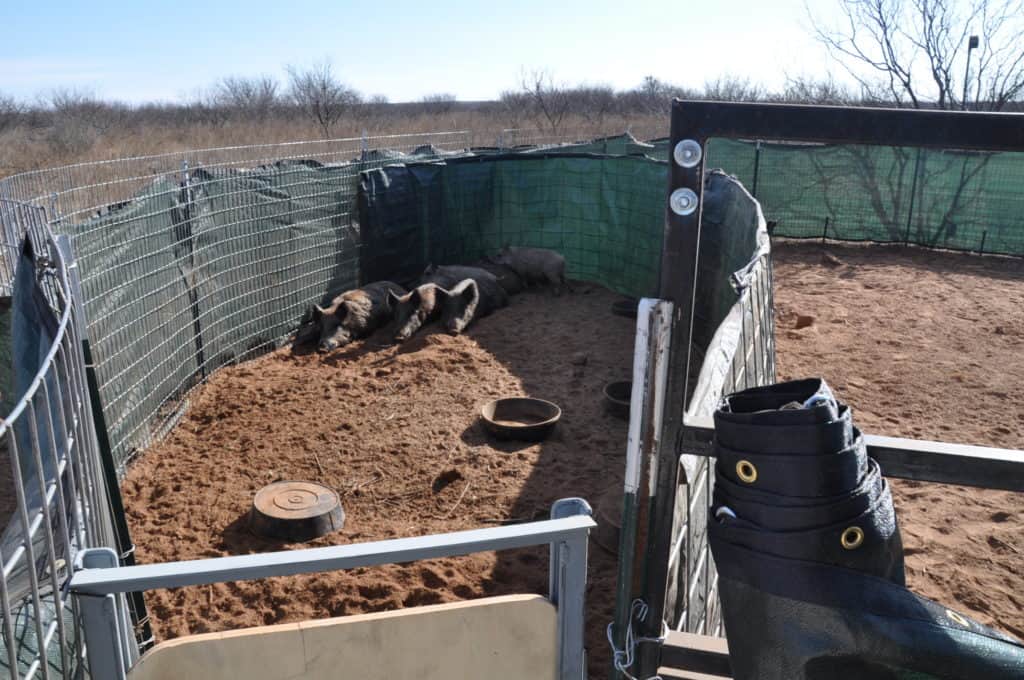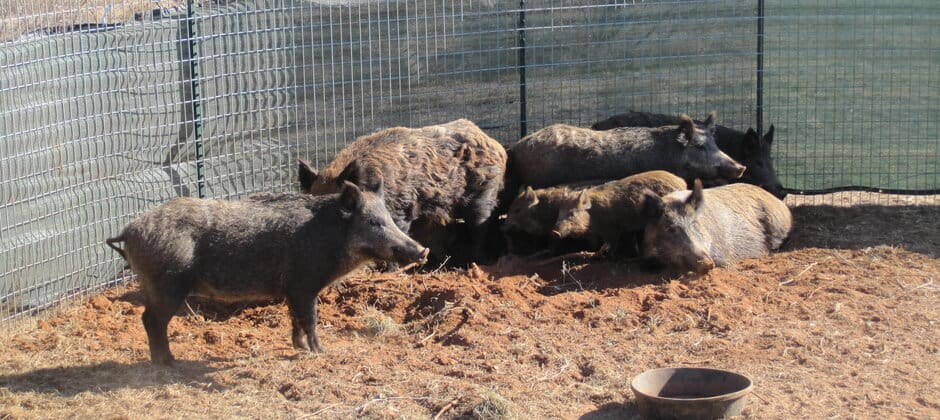Share this article
WSB: Tracking feral swine sounders
Researchers are determined to learn as much as they can about feral pigs’ group dynamics by developing special tools to track dozens of individuals at a time.
Feral swine (Sus scrofa) are a massive problem in North America, damaging agriculture and human development, as well as causing ecological problems that impact native species across the continent. The pigs breed rapidly and can survive in a variety of landscapes from the southern U.S. to Canada. Agencies, universities and other organizations have invested millions of dollars in research to develop better methods and strategies to control invasive pig populations.
But one research blind spot so far has been understanding the group dynamics of sounders — the herds the pigs usually form based partly on family. Researchers know little about how these groups are structured and change over time. Better understanding of how sounders form and what type of individuals they consist of could help wildlife managers control the invaders’ spread.

Researchers work with a few sedated, collared pigs.
Credit: USDA Wildlife Services, National Wildlife Research Center
“It’s about getting the whole picture,” said Michael Lavelle, a wildlife biologist working with the Feral Swine Research Project at the U.S. Department of Agriculture’s Animal and Plant Health Inspection Service, about the research. “It’s about [learning] as much about pig ecology and sounder dynamics as we can.”
Lavelle, the first author of a study on the pigs published recently in the Wildlife Society Bulletin, has been trapping feral swine for more than a decade. Early on, he used a conventional technique that involved targeting one adult from a sounder in a particular area. Tracking devices placed on the animal informed researchers about the overall sounder’s behavior.
“We pretty much used that one individual to tell us anything and everything about pigs as a whole in the area,” Lavelle said.
The trouble was that researchers were uncertain if the tagged individual managed to rejoin the same sounder. They also didn’t know if it stayed permanently with the same sounder, or how the dynamics of the sounders worked.
To learn more detailed information, researchers would need to capture an entire sounder at once, marking all of the individuals in the group and fitting some with tracking devices.
In the new study, the team employed a technique frequently used to capture and control feral swine. They baited and trapped them in corrals, only closing the gate when the whole sounder was inside.
Trail cameras placed near the corral showed when the sounder entered the enclosure. Once all the pigs were inside, the gates were closed remotely using a cell phone.

A few pigs wait in the corral, with the chute in the foreground.
Credit: USDA Wildlife Services, National Wildlife Research Center
The researchers learned the best way to control the pigs once they were in the corral was to cover the see-through wire barrier with a shroud, so the trapped animals couldn’t see the researchers. Lavelle said this helped reduce the pigs’ stress and fear inside the corral, which in turn helps to control the pigs in subsequent steps. “We can typically put [the shroud] up in less than 60 seconds,” he said. At that point, “the pigs are just standing there waiting for the next thing to happen.”
To remove pigs from the corral one-by-one for processing, the researchers attached an enclosed chute and ramp from the corral to a modified livestock trailer— the type you might see carrying horses on the highway.
Lavelle and his colleagues modified the trailer to have several sequential compartments with guillotine doors. As the sounder goes through the chute, pig-by-pig, researchers close the doors between compartments to isolate individuals.
They were initially worried that it might be difficult to get the pigs into the trailer, but this step proved relatively easy. Just having a person stand on one side of the corral was enough for the pigs to run into the chute without much prompting.
“The only escape route they had was up into the chute,” Lavelle said.
Separating individual pigs into different compartments made it easy for researchers to sedate the swine. All they had to do was reach in and jab them with a pole syringe. Since they were able to get so close to the pigs, they could administer accurate doses based on each pig’s size and weight.
In addition to weighing and measuring the pigs, the researchers took tissue or blood samples. They also fit the pigs with tags and tracking devices. Once the animals woke up, the researchers ushered them back into the holding corral, where they waited until every individual in the sounder worked off its grogginess from the tranquilizer. They then opened the gate, releasing the pigs en masse, as seen in the video above.
Lavelle and his colleagues have used this technique a number of times, fine tuning each stage to iron out the kinks. Overall, he said “it looks like we’ve done a much better job of keeping the sounder intact.”
In addition to allowing for data collection on entire sounders, the technique is safer for wildlife researchers and the pigs by reducing trap-related injuries and stress in the animals.
Lavelle hopes that by using this technique more widely, researchers will learn more about the way individuals move in and out of sounders. He added that this set up could be used with different animals or slightly modified to fit individual research projects as needed.
This article features research that was published in a TWS peer-reviewed journal. Individual online access to all TWS journal articles is a benefit of membership. Join TWS now to read the latest in wildlife research.
Header Image: A sounder in a corral. Credit: USDA Wildlife Services, National Wildlife Research Center








